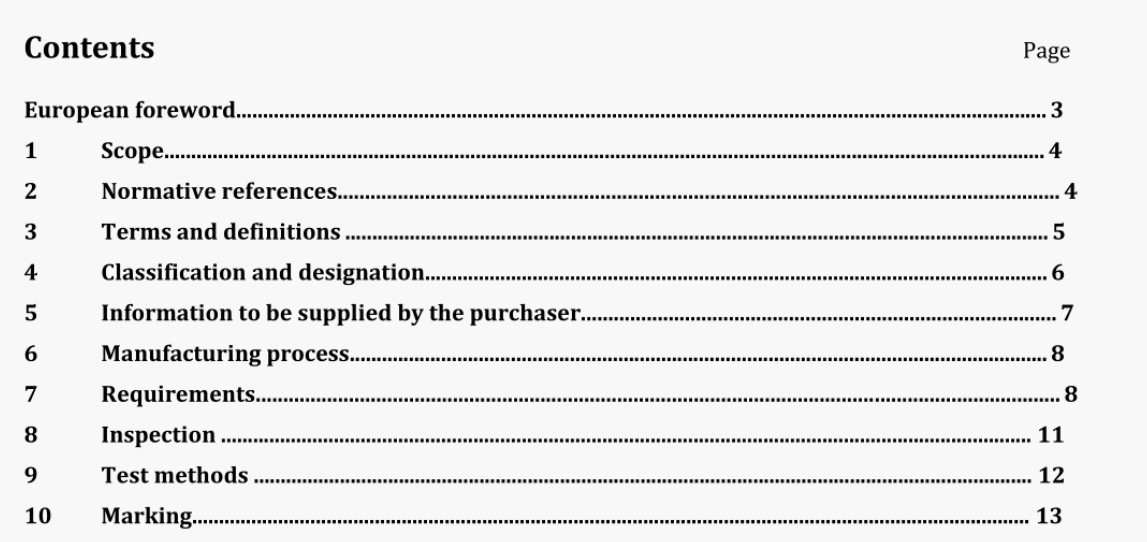BS EN 10277:2018 pdf download.Bright steel products – Technical delivery conditions
1 Scope
This document specifies the technical delivery requirements for bright steel bars in the drawn,peeled/turned or ground condition and they are intended for mechanical purposes, for example for machine parts. The bright bars are subdivided into the following steel types:
a) non-alloy general engineering steels;
b) non-alloy free-cutting steels;
c) non-alloy and alloy case-hardening steels;
d) non-alloy and alloy steels for quenching and tempering.
This document lists the mechanical characteristics for products up to 100 mm in thickness. For larger dimensions, the manufacturer and purchaser agree on mechanical properties at the time of enquiry and order.
It does not cover cold rolled products and cut lengths produced from strip or sheet by cutting. Bright steel products of stainless steels are to be found in EN 10088-3.
In addition to this document, the general technical delivery requirements of EN 10021 are applicable.
2 Normative references
The following documents are referred to in the text in such a way that some or all of their content constitutes requirements of this document. For dated references, only the edition cited applies. For undated references, the latest edition of the referenced document (including any amendments) applies.
EN 10020, Definition and classification of grades of steel
EN 10021:2006, General technical delivery conditions for steel products
EN 10025-2, Hot rolled products of structural steels – Part 2: Technical delivery conditions for non-alloy structural steels
EN 10027-1, Designation systems for steels – Part 1: Steel names
EN 10027-2, Designation systems for steels – Part 2: Numerical system
EN 10079, Definition of steel products
EN 10204, Metallic products – Types of inspection documents
EN 10247, Micrographic examination of the non-metallic inclusion content of steels using standard pictures
CEN/TR 10261, Iron and steel – European standards for the determination of chemical composition
EN ISO 148-1, Metallic materials – Charpy pendulum impact test – Part 1: Test method (ISO 148-1)
EN ISO 377, Steel and steel products – Location and preparation of samples and test pieces for mechanical testing (ISO 377)
EN ISO 643, Steels – Micrographic determination of the apparent grain size (ISO 643)
EN ISO 683-1, Heat-treatable steels, alloy steels and free-cutting steels – Part 1: Non-alloy steels for quenching and tempering:(SO 683-1)
EN ISO 683-2, Heat-treatable steels, alloy steels and free-cutting steels – Part 2: Alloy steels for quenching and tempering (ISO 683-2)
EN ISO 683-3, Heat-treatable steels, alloy steels and free-cutting steels – Part 3: Case-hardening steels (ISO 683-3)
EN ISO 683-4,Heat-treatable steels, alloy steels and free-cutting steels- Part 4: Free-cutting steels (ISO 683-4)
EN ISO 3887, Steels – Determination of the depth of decarburization (ISO 3887)
EN ISO 4885, Ferrous materials – Heat treatments – Vocabulary (ISO 4885)
EN ISO 6506- 1, Metallic materials – Brinell hardness test – Part 1: Test method (ISO 6506-1)
EN ISO 6892-1, Metallic materials – Tensile testing – Part 1: Method of test at room temperature (ISO 6892-1)
EN ISO 14284, Steel and iron – Sampling and preparation of samples for the determination of chemical composition (ISO 14284)
ISO 286-2, Geometrical product specifications (GPS)- ISO code system for tolerances on linear sizes -Part 2: Tables of standard tolerance classes and limit deviations for holes and shafts
ISO 4967, Steel- Determination of content of non-metallic inclusions – Micrographic method using standard diagrams
BS EN 10277:2018 pdf download
